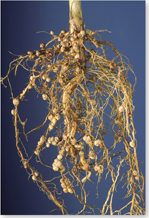Nitrogen Fixers All organisms need nitrogen to make proteins and other molecules. But while nitrogen gas (N2) makes up 80 percent of Earth's atmosphere, only a few kinds of organisms—all of them prokaryotes—can convert N2 into useful forms. The process of nitrogen fixation converts nitrogen gas into ammonia (NH3). Ammonia can then be converted to nitrates that plants use, or attached to amino acids that all organisms use. Nitrogen-fixing bacteria and archaea provide 90 percent of the nitrogen used by other organisms. The rest is provided by nitrogen-containing compounds from weathering rocks. Some even comes when lightning combines oxygen and nitrogen in the atmosphere.
Some plants even have symbiotic relationships with nitrogen-fixing prokaryotes. The bacterium Rhizobium grows in nodules, or knobs, on the roots of legume plants such as clover and soybean. The Rhizobium bacteria within these nodules convert nitrogen in the air into the nitrogen compounds essential for plant growth. In effect, these plants have fertilizer factories in their roots!
 In Your Notebook Outline three important functions of prokaryotes in the environment. Fill in supporting details for each of these functions.
In Your Notebook Outline three important functions of prokaryotes in the environment. Fill in supporting details for each of these functions.

FIGURE 20–14 Rhizobium These soybean root nodules contain Rhizobium bacteria.
Human Uses of Prokaryotes Prokaryotes, especially bacteria, are used in the production of a wide variety of foods and other commercial products. For example, yogurt is produced by the bacterium Lactobacillus. Some bacteria can even digest petroleum and remove human-made waste products and poisons from water. Others are used to synthesize drugs and chemicals through the techniques of genetic engineering.
Biologists continue to discover new uses for prokaryotes. For example, bacteria and archaea adapted to extreme environments may be a rich source of heat-stable enzymes that can be used in medicine, food production, and industrial chemistry.
20.2 Assessment

-
Review Which two domains of life contain only prokaryotes?
Interpret Diagrams Review Figure 20–7. Which feature of the cell wall is characteristic of bacteria but not of archaea?
-
Review In what ways do prokaryotes differ from one another?
Evaluate Review Figure 20–10. Which category of prokaryote is the most flexible in the energy sources it can use? Explain.
-
Review List three ecological roles played by prokaryotes.
Explain Why are nitrogen-fixing bacteria so important?
Apply Concepts Many farmers practice “crop rotation” by planting a field with corn one year and soybeans the next. Why might they do this?
WRITE ABOUT SCIENCE
Suppose a new bacterial species is discovered that is spherical in shape, survives drought by forming a thick outer wall, and cannot survive without oxygen. Using vocabulary terms from this lesson, describe this species to a scientific audience.

Table of Contents
- Formulas and Equations
- Applying Formulas and Equations
- Mean, Median, and Mode
- Estimation
- Using Measurements in Calculations
- Effects of Measurement Errors
- Accuracy
- Precision
- Comparing Accuracy and Precision
- Significant Figures
- Calculating With Significant Figures
- Scientific Notation
- Calculating With Scientific Notation
- Dimensional Analysis
- Applying Dimensional Analysis




